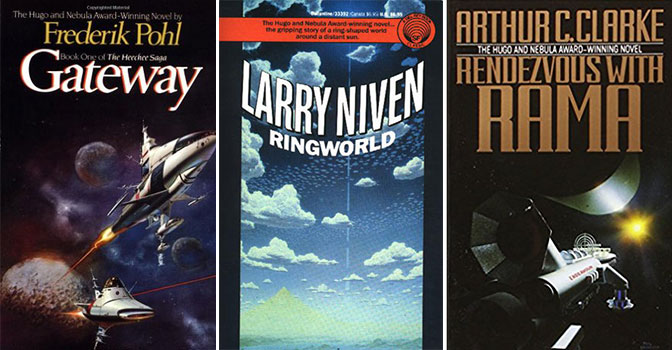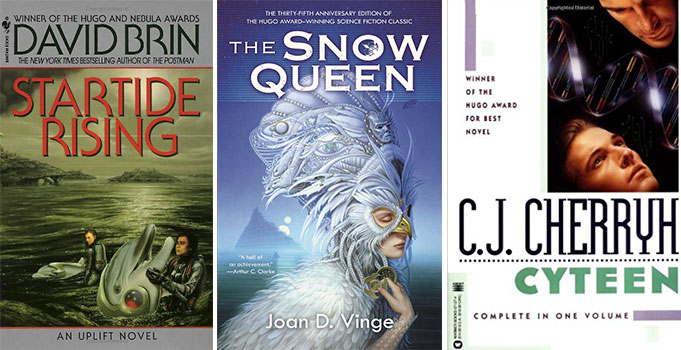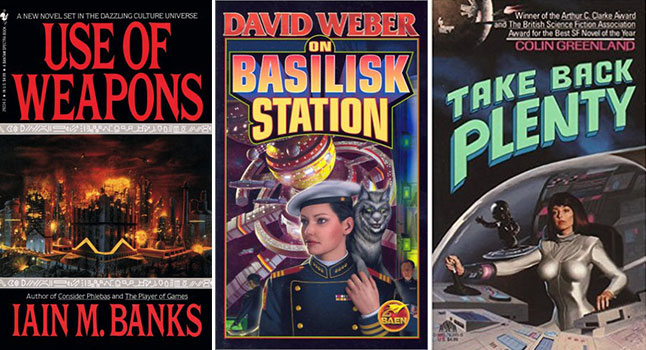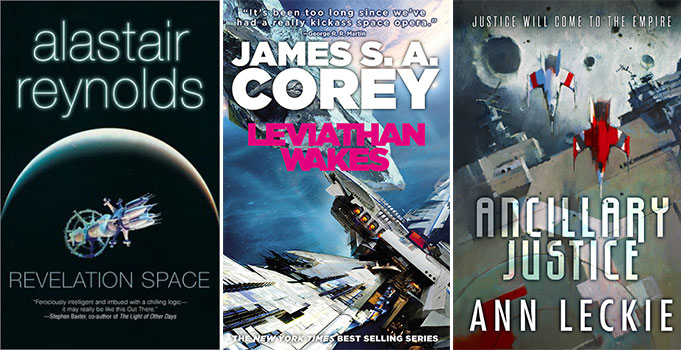55 Essential Space Operas from the Last 70 Years

What makes a science fiction story a space opera? Well, it needs to take place in space obviously, though not necessarily all of the time. Hanging out solely in an arcology on a climate-blasted Earth, or even in a domed city on Mars, doesn’t cut it. Actually, the more space the better; though there are certainly exceptions, a good space opera should span a galaxy or two, or at least a solar system. And an opera has to be grand and dramatic –battling empires, invading aliens, mysterious ancient technology, and grand, sweeping story arcs.
Here are 55 science fiction stories from the last 70 years that make the cut.

Classic Space Opera
Space opera was a staple of the pulp and golden ages of science fiction. Blazing starships, super weapons, epic galaxy spanning battles, tentacled aliens, and valiant heroes (very few heroines).
The First Lensman (The Lensman Series), by E. E. “Doc” Smith
Nominated for the Hugo Award for Best All Time Series, the books of The Lensman Series recount the adventures of the Galactic Patrol. A super-intelligent alien race gives worthy members of the Galactic Patrol a “Lens” that gives the wearer telepathic and other powers, and makes them prone to encountering exciting adventures.
The Big Jump, by Leigh Brackett
Leigh Brackett is probably best known among sci-fi fans today for what amounted to a blip on her long resume: she penned an early draft of The Empire Strikes Back. To focus on that ignores an illustrous career as a novelist and short story writer that spanned decades and earned her the title “The Queen of Space Opera.” Much of her work is hard to find these days, but The Big Jump, about a ship that vanishes using an experimental star drive, and what happens when it comes back, more than holds up today.
The Star Kings (Star Kings Series), by Edmond Hamilton
John Gordon from the 20th century finds himself in the body of Prince Zarth Arn, 2,000 centuries in the future. With Lianna from the Kingdom of Fomalhaut, John/Zarth must defend the Empire World from the tyranny of the Black Cloud.
Foundation (Foundation Series), by Isaac Asimov
Using the science of Psychohistory, the Foundation tries to save human knowledge and civilization as the galactic Empire collapses. (The Foundation trilogy won the Hugo Award for Best All-Time Series in 1966.)
The Paradox Men, by Charles L. Harness
Alar survives the crash of his spaceship on a future Earth but loses his memory. He joins the Society of Thieves against Imperial America, and realizes that he has special powers. His search for understanding takes him to a climax on a huge platform collecting matter from the sun.
The Stars My Destination, by Alfred Bester
Gully Foyle seeks revenge against those who abandoned him in space. But in his quest, he finds a way to give humanity the stars. With its amoral protagonist and body modifications galore, this retelling of The Count of Monte Cristo could also arguably be called the first cyberpunk novel.
Cities in Flight, by James Blish
Something called a “spin-dizzy” serves as both anti-gravity drive and protective shield that allows entire cities flee a totalitarian Earth for space. These cities, known as “Okies,” travel to the stars in search of work.
Witch World, by Andre Norton
Like Leigh Brackett, Norton is a legendary sci-fi writer who published dozens of books—many of them now sadly out of print. Perhaps her most enduring creation was the shared universe of Witch World, a science fantasy setting that blends elements of technology and magic. Norton wrote novels and stories in Witch World for over four decades, but it all began with a single novel, published in 1963.
Starship Troopers, by Robert A. Heinlein
Juan “Johnny” Rico, is fighting in the Terran Mobile Infantry against the alien Arachnids. The infantry uses powered armor for enhanced speed and power. Through a series of flashbacks, the reader learns how Johnny rose through the infantry ranks. (Heinlein also uses flashbacks to Johnny’s high school classes to present his ideas about society and the role of the military.)
Bill, the Galactic Hero, by Harry Harrison
A satirical take on the tropes of space opera. Bill is shanghaied into the Space Troopers. He accidentally becomes a hero in the war against the reptilian Chingers, then gets lost on his way to receive a medal from the emperor and is branded a deserter.
Dune, by Frank Herbert
The desert planet Dune is the sole source of the spice melange that is the basis for interstellar travel. Paul Atreides, the young son of a Duke, is caught up in the battle for the control of that planet and its spice. When Paul becomes the leader of Dune’s Fremen, he threatens the empire and alters the course of human history. A few more books followed.
The Ship Who Sang, by Anne McCaffrey
Though best known for her (arguably sci-fi) Dragonriders of Pern series, Anne McCaffrey dabbled in more obvious space opera territory in this 1969 novel (and sequels!) about sentient “brainships,” star-traveling cyborg vessels implanted and controlled by living, formerly human minds.
Nova, by Samuel R. Delany
It only stands to reason that a space opera by the author of Dhalgren would be somewhat less than conventional, and Nova—a wild piece of experimental lit that blends film noir, grail myths, intrigue, the gruesome touches of gothic horror fiction, and proto-cyberpunk flourishes for good measure—delivers, and then some. Delany’s novel of the struggle between the Von Rays and the sadistic Prince and Ruby Red occupies an odd space alongside works like The Stars My Destination, but leans further into the darker themes most of its contemporaries pulled just back from.

Space Opera and the New Wave
Many SF authors felt that the lurid space operas of the pulp era were something to be lived down. The “New Wave” and cyberpunk took science fiction in new directions. But some authors brought those sensibilities to the space opera.
The Centauri Device, by M. John Harrison
A powerful sentient weapon, known as the Centauri Device, has been uncovered. But it can only be activated by a member of the now extinct Centauran race. When warring factions discover that a non-descript spaceship captain, John Truck, is half Centrauran, the battle begins to find and control him.
Gateway (Heechee Saga), by Fredrick Pohl
Humanity finds an asteroid full of ships left behind by advance alien civilization. We figure out how to pilot them, but can’t predict where they’ll go—or how long the journey will take. Using one of the ships may bring you great riches, or death. For our damaged, near-broken narrator, it was both.
Ringworld, by Larry Niven
A huge ring, with a habitable area three millions times that of Earth, is found circling a distant star. A crew of humans and aliens sent to explore the Ring crash-lands and has to struggle to survive and escape.
The Forever War, by Joe Haldman
In a future war, troop ships travel between stars at relativistic speeds, which means for every year on the ships decades, even centuries, pass back on Earth. As a result, the soldiers become increasing alienated from the Earth that they defend.
Rendezvous with Rama, by Arthur C. Clarke
Scientists discover a huge cylindrical object entering the solar system is an interstellar ship. When it becomes clear that the ship will not stop or even slow in the solar system, an expedition is mounted to explore it.

Hits of the ’80s
What’s most remarkable about the biggest space operas of the 1980s is how many of them still resonate today—to the point that some of these series are still chugging along, more than three decades later.
The Snow Queen, by Joan D. Vinge
Due to a bunch of wonky sci-fi reasons involving an orbit around a black hole, the planet Tiamat, the setting of this Hugo Award–winning sci-fi classic, has lovely, 150-year-long summers…and generations-long winters to match. The outgoing Snow Queen, Arienrhod, is supposed to step down, to make way for the long rule of the next Summer Queen, the innocent child Moon. But Arienrhod has set another long-gestating plan in motion…
Startide Rising (Uplift Series), by David Brin
A complex galactic society is based on one species uplifting another to sentience, but no one know who uplifted humans. A starship crewed by dolphins and humans discover what may be a derelict fleet of the legendary first sentient race. Alien races fight to gain the secret of that fleet. Winner of the Hugo and Nebula awards.
Hyperion, by Dan Simmons
On the planet Hyperion a time traveling terror called the Shrike is due to appear. Seven pilgrims seek the Shrike as the Ousters, considered interstellar barbarians, prepare to invade Hyperion.
Ender’s Game, by Orson Scott Card
Earth is losing the war against the alien “Bugs”. In desperation they recruit child warriors, including 6 year-old Ender Wiggin, into an elite Battle School that will train them fight by remotely controlling fleets of ships.
Cyteen, by C. J. Cherryh
Genetic engineering is prevalent on the planet Cyteen, making it a power in the Union. Some humans, called “azi” are cloned and conditioned from birth as servants. A murdered brilliant scientist is cloned in the hope that her brilliance will again be a resource for Cyteen. But the murder itself remains unsolved.
Shards of Honor, by Lois McMaster Bujold
Bujold’s Vorkosigan Saga is the most enduring, most-awarded space opera of the last 30 years. It follows the exploits of the titular family in the far future, when humanity has spread across the stars, colonized different worlds, and continued to grow apart. The story begins with 1986’s Shard of Honor, in which Lord Aral Vorkosigan and Captain Cordelia Nasmith, on different sides of a conflict between worlds, meet and fall in love after they are both stranded on the same hostile planet. As you do.
Agent of Change, by Sharon Lee and Steve Miller
A long-running series to rival the Vorkosigan Saga, Lee and Miller’s Liaden Universe series recently published its 20th installment. It all got started with 1988’s Agent of Change, set in a universe where a diaspora has forced humanity to spread across the stars, and to evolve into three distinct sub-species—the Terrans, the warrior-like Yxtrang, and the honorable, technologically advanced Liadens. (Unlike the Vorkosigan Saga, there are aliens in the mix too.)
Neverness, by David Zindell
In the far future a caste of mathematicians are the pilots of starships. One pilot, Mallory Ringess, begins a quest for the Elder Edda, believed to hold the secret to immortality. His quest takes him to the Solid State Entity, a nebula sized computer, and to the Alaloi tribe whose genes have been mutated back to the Neanderthals.

The 1990s and the New British Space Opera
The ’90s saw the start of a shift in space opera that would come to represent a major movement: the New British Space Opera, which saw authors out of the U.K. penning works that used the tropes of space opera to tell darker stories, filled with antiheroes (or no heroes at all) and complex morality.
Use of Weapons, by Iain M. Banks
Though it technically kicked off in the late ’80s, Iain M. Banks Culture novels could be said to be the genesis of what came to be known as the New British Space Opera in the ’90s and 2000s. An twist on utopian space operas, The Culture presents a future where benevolent AIs govern everything, genetic engineering has resulted in immortality and perfected human design, and the most powerful faction in the universe (next to the energy beings) is the Culture, a group of cheerful collectivists with massive, heavily armed sentient starships. Banks’ imaginative world design and massive scope is paired with an iconoclastic and anarchic sense of humor for a modern classic.
Take Back Plenty, by Colin Greenland
Aliens have given humans a faster than light drive but restricted them to the solar system. Tabitha Jute is in danger of losing her ship and her best friend, the ship’s sentient AI. Then a mysterious man hires her to take him to the space station Plenty.
A Fire Upon the Deep, by Vernor Vinge
A ship bearing the only defense against a malevolent Transcendent intelligence crashes on a planet inhabited by medieval lupine aliens. A rescue ship races to save the survivors, two children, and recover the weapon.
Vacuum Diagrams (Xeelee Sequence), by Stephen Baxter
This series tells the tale of humanity’s expansion into the cosmos and their battle with the Xeelee, an advanced alien civilization. The stories in this collection connect all the novels, which cover a timeline from the Big Bang to the heat death of the universe.
Vast, by Linda Nagata
Using a “cult virus” and automated warships, the alien Chenzeme have waged war on humans for millions of years. The human crew and passengers of the Null Boundary, a giant starship thousands of years old, are trying to find out why.
On Basilisk Station (Honor Harrington Series), by David Weber
Having embarrassed a superior officer, Commander Honor Harrington is assigned to picket duty at an out-of-the-way solar system. But she and the crew of her aged light cruiser HMS Fearless discover and have to try to defeat an invasion plan. This is the start of an expansive series (totaling more than 30 volumes to date) from a very prolific author.
Deathstalker (Deathstalker Series), by Simon R. Green
Owen Deathstalker, reluctant head of a warrior clan, is forced out of his simple life as a historian when the Empress capriciously puts a price on his head. Owen then finds himself drawn into a battle against the despotic Empress, known as the “Iron Bitch.”
The Real Story: The Gap into Conflict (The Gap Cycle), by Stephen R. Donaldson
A pair of space pirates and ex-cop shift between the roles of hero, villain, and victim as they fight for survival. The rest of the series reveals how those three characters are pawns in a much bigger political game where Earth is dependent on resources from deep space.

21st Century Space Opera
Space opera is alive and kicking in the 21st century. In fact, it can be argued that the genre, enriched by new voices and new ideas, has never been healthier.
Revelation Space (Revelation Space Series), by Alastair Reynolds
While investigating the destruction of a past advanced alien civilization, a man discovers a threat to all intelligent life in the galaxy. Cybernetically altered humans, alien races, a neutron star turned into a computer, all figure into the search for a way to counter that threat.
The Quantum Rose (Saga of the Skolian Empire), by Catherine Asaro
This Nebula-winner is a retelling of the Beauty and the Beast in a science fiction setting—the Beast is Havyrl Lionstar, exiled prince from the planet Lyshriol, scarred in an interstellar war; the Beauty is Kamoj Argali, a provincial governor from the planet Balumi. Kamoj must save her province from Lionstar, then she helps him save his planet.
Trading in Danger (Vatta’s War), by Elizabeth Moon
Expelled in disgrace from the military academy, Kylara Vatta is given a chance for redemption as captain of one of her family’s transport ship. When she take a detour from her assigned journey, Ky and her crew land in the middle of a colonial war.
The Quiet War, by Paul McAuley
Humans known as the Outers have settled of the moons of Jupiter and Saturn, dependent on genetic engineering to survive. On Earth the tyrannical regimes of the great families attempt to undo the environmental ravages there. These two branches of humanity may be headed for war.
The Commonwealth Saga, by Peter F. Hamilton
Encompassing several trilogies and colloquially known as “the one with all the trains,” Commonwealth is the millennia-spanning story of a transhuman utopia’s first contact with godlike aliens. While the novels in The Commonwealth Saga are almost impressively dense and huge, Hamilton’s focus on the individual character conflicts and knack for keeping the narrative moving even at its slowest makes this far-future epic an important point in the space opera canon, and an enjoyable one as well.
Old Man’s War, by John Scalzi
Humanity reaches the stars but finds them a battlefield over scarce resources. Earth’s Colonial Defense Force recruits experienced individuals over 65, gives them new, better bodies, and throws them into battle.
The Singularity Sky, by Charles Stross
The Eschaton, a powerful sentient AI created by humans, triggered an event known as the Singularity in the 21st century. 150 years later what remains of humanity has reached the stars, but they are now threatened by an alien information plague known as the Festival.
Praxis (Dread Empire’s Fall), by Walter Jon Williams
For thousands of years the alien Shaa have subjugated humanity and numerous other races. Now the last of the Shaa are dying and the struggle for control of the empire, or freedom from it is beginning.
Prador Moon (The Polity Series), by Neal Asher
First contact between humans and the hostile alien Prador erupts into war. The other Polity novels continue the tale of that war, along with the benevolent AI’s that rule humanity’s Polity Collective, rogue AI’s, secret agent Ian Cormac, a huge bioconstruct called the Dragon, runcible gates that can connect galaxies, and many other wonders.
Newton’s Wake: A Space Opera, by Ken MacLeod
In the Hard Rapture Earth’s artificial intelligences become godlike entities, triggering a cataclysmic war. The humans who survive start to use a series of stargates that those entities left behind and activate an artifact of unknown origin.
Warchild, by Karin Lowachee
Eight year old Joslyn Musey is taken by the space pirates who killed his parents. Then he is captured by the alien “strits”, at war with the humans of EarthHub. Jos is trained by a human sympathizer on the strits’ homeworld to spy against the EarthHub. But when he joins the crew of the EarthHub ship the Macedon Jos discovers good and bad made not be as simple as he thought.
Leviathan Wakes (The Expanse), by James S. A. Corey
There is an uneasy truce between Earth, Mars, and the asteroid belt. The discovery of an alien lifeform disrupts that balance. And that lifeform has plans of its own.
Ancillary Justice, by Ann Leckie
Sentient ships control hundreds of ancillary human bodies to maintain an interstellar empire. But a soldier’s quest for revenge could destroy the empire. Winner of the Hugo, Nebula, and Arthur C. Clarke awards.
Ascension, by Jacqueline Koyanagi
Alana Quick is a starship mechanic who signs on to a crew of a very, very strange ship in order to search for her spiritually-advanced sister, Nova. The strange happenings on board the Tangled Axon are the least of her worries: Nova is in a considerable amount of danger, and someone out there is willing to destroy planets to get to her. Koyanagi injects gender and racial twists into traditional space opera DNA, making this book stand apart from the rest of the fleet.
The Long Way to a Small Angry Planet, by Becky Chambers
The ship Wayfarer with her crew of humans and aliens is offered a job building a wormhole to an alien planet. It seems a straightforward, lucrative mission. But the political situation is more complex, and dangerous than they know.
The Stars Are Legion, by Kameron Hurley
Two organic world sized ships of the Legion battle for control of the rogue ship Mokshi. Zan, a woman with no memories, struggles to survive while she tries to uncover her past to find where her true loyalty should lie.
Fortune’s Pawn, by Rachel Bach
Devi Morris is a mercenary with big plans. Signing on to the ship Glorious Fool seems like a good start. But she soon finds out that there is more to the ship and its mission than she could have guessed. And who doesn’t love a kick ass heroine wearing power armor?
The Cold Between, by Elizabeth Bonesteel
Treiko Zajec is chief suspect in the murder of a crewmate. But his lover Commander Elena Shaw knows he is innocent. Trey and Elena find that the murder may be connected to the destruction of a Central Corps starship near a wormhole 25 years earlier. Can they solve this mystery before it plunges the sector into war?
Behind the Throne (The Indranan War), by K. B. Wagers
Hail Bristol has made a name for herself in the galaxy as a gun runner. But now she has been dragged back her home planet as the last remaining heir to the Indranan Empire. This time she cannot run away from her responsibilities. And she must discover who assassinated her sisters before she is next.
The Three-Body Problem (Remembrance of Earth’s Past), by Cixin Liu
Celebrated Chinese SF author tells the tale of humanity’s first contact with an alien civilization. The threatened invasion by those aliens, the Trisolarians, will take four hundred years to arrive but it drastically changes human civilization. And neither civilization knows how dangerous the galaxy can truly be.
On a Red Station, Drifting (Xuya Universe), by Aliette de Bodard
In this alternate history, China discovered the Americas before the West, and the Aztec empire continued into the modern era as Mexica (sic). These cultures remain dominant into the 21st and 22nd Centuries. Large AI’s, called Minds, can pilot ships into deep space, establishing colonies there.
City of Pearl (Wess’Har Wars), by Karen Traviss
Three different alien species and humans compete for the resources of the planet Bezer’ej. Shan Franklin, a human former environmental police officer, arrives to find out what happened to the human colonists. And Aras, a Wess’Har made immortal by a parasite, will go to great lengths to protect the ecological stability of Bezer’ej.
Ninefox Gambit (Machineries of Empire), by Yoon Ha Lee
In the far future human society is regulated by an intricate form of social mathematics. When heretics seize a star fortress Captain Kel Cheris is sent to retake the fortress. Cheris has to ally herself with the undead general Shuos Jedao. Jedao has never lost a battle but he made be insane.
Editor’s note: Sam Reader also contributed to this article.
What space operas do you consider essential?